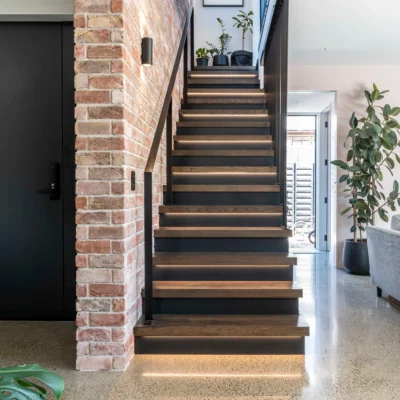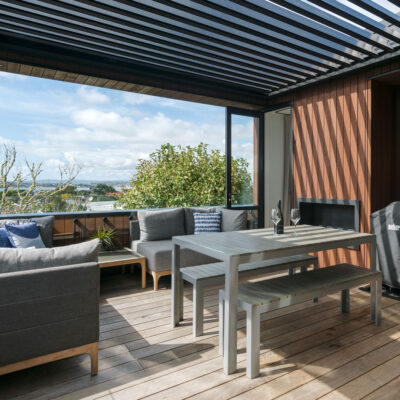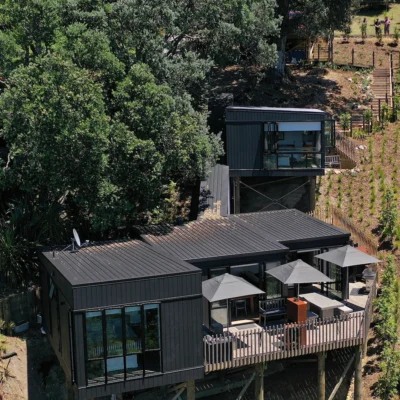What’s inspired us:
It’s not often you can buy an off-the-shelf product that helps fight the housing crisis and the climate crisis all in one go. But IKEA aims to do just that with its eco-responsible trailer-mounted tiny house. Box™ has always admired the ethos of the Swedish company’s founder, Ingvar Kamprad, who was born on a farm and went from humble beginnings selling matches around his neighbourhood to the most innovative furniture retailer in the world. But can the same ‘affordable style’ formula work on this 18-square-metre home?


The design, developed in partnership with an American RV builder, is a simple black box clad in engineered timber that looks like shou sugi ban – the ancient Japanese technique of surface charring wood to preserve it. The metal roof is kitted out with solar panels. As you would expect, the interiors are Scandi style: the walls are lined with sustainably grown whitewashed pine, pale wood is on the floors, and the spaces are filled with IKEA furniture and homewares. In the kitchen, the striking black cabinetry fronts are made from recycled wood coated in a plastic protection material made from recycled PET bottles. The bench-top is timber veneer, made from branches and twigs of the trees so there’s no waste, and there’s a sleek portable induction cooktop (which is a relatively new product on the market but seems to make sense in a tiny home). The dining zone features a gate-leg table that can be folded away while the bed lifts up to provide extra storage. The bathroom is kitted out with a composting toilet, gas water heating and low-flow taps in the shower. The towel rail is made from recycled material and there’s a crocheted storage hanger – handcrafted of course.
Which brings us to the inevitable question: how much do the IKEA tiny homes cost? Dig deep into the marketing and you arrive at a figure of US$55,000 or in that vicinity. Sadly, the functionality and value of this latest IKEA product remains to be proven because the pandemic has pushed pause on the retailing. If you’re still curious though, here’s a link to a virtual tour.
What’s got us thinking:
Like many of you recently, we’ve been making the most of the not so ‘Unstoppable Summer’ by exploring the Great Walks and some off-the-beaten tracks of Aotearoa. It got us thinking about the architectural heritage tied up in the utilitarian huts that are not only built for recreation but to give shelter to those who work in the wilderness. Did you know that there are about 1400 huts in New Zealand’s back country? That’s a lot of perfectly formed little buildings enhancing and enriching lives.

These simple structures are symbolic of the Kiwi DIY culture and pioneering spirit. Traditional crafts like hewing, splitting and pit sawing of timber found at the location helped shape the vernacular. For roofing it was a case of transporting the materials to these remote sites, often on your own back or, if you were lucky, that of a horse! The easiest option was to use corrugated tin which could be rolled up in sheets to be used for both roofing and cladding.

Some ‘huts’ built in the 1800s are still around today. These include Ellis Hut (built 1884), the oldest surviving hut in the Ruahines and infamous for being the temporary hideout of murderer Jack Ellis, and Stella Hut which is on Enderby Island on the Auckland Islands. It dates back to 1880 and is one of few surviving ‘castaway’ huts. It was made by the crew of the lighthouse steamer ‘Stella’ and stocked with supplies to support those who found themselves shipwrecked on the subantarctic island – a not uncommon occurrence back in those times.

The newest DOC huts – like the ones on the Paparoa Track, a Great Walk that weaves up and over the alpine ranges through the West Coast fairy forest and along the river to the coast at Punakaiki – still have the flavour of yesteryear. Clad in corrugated-iron in jaunty Pioneer Red, the Moonlight Tops hut delivers the basics of shelter, a place for food preparation, room to sling your sleeping bag and the inevitable long drop. But so much more. Sitting on the small deck to watch the sun set into the misty valleys below is a memorable, wraparound experience.

If you’re a fan of the built history that is the foundation of so many huts, you might be interested in aiming for the top of the charts on hutbagger.co.nz. Similar to the system of ‘peak bagging’ in the UK, once you’ve visited a hut you can add it to a list and post it to the website. But you better get a hustle on. The top hut bagger already has a tally of 1048 unique huts to his name.
What’s got us perambulating:

Here’s something to do now that you’re back from the beach and before the weather turns…get a newfound appreciation for the urban fabric of our biggest city and the buildings that knit it together. It has been two years since the handy pocketbook (Auckland Architecture: A Walking Guide) was published but with overseas cities now out of reach due to border closures, what better time to explore the built backyard you’ve taken for granted for so long? Not every historical building in Tāmaki Makaurau has been destroyed – thank heavens. There are 50 significant ones over six mapped out routes still to discover. That’s more than a month of Sundays sorted right there. You can order a copy online here. https://www.masseypress.ac.nz/books/auckland-architecture/






